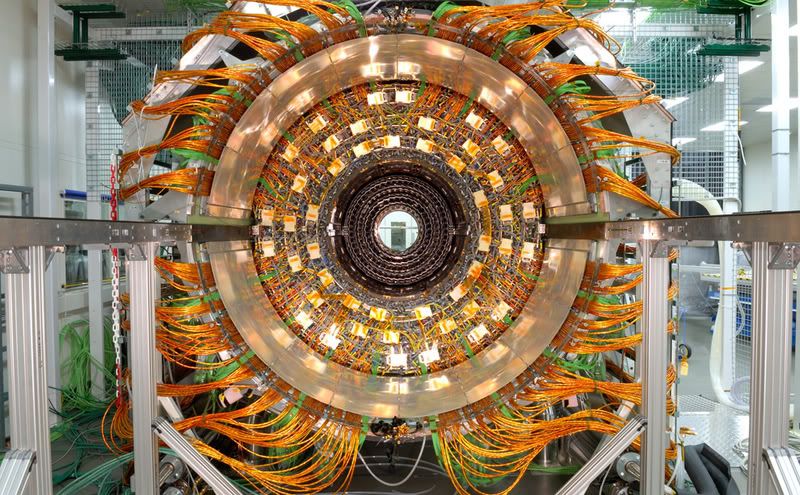 To read the tribute to SFC Marcus Muralles, please click here
To read the tribute to SFC Marcus Muralles, please click here 
Friday, August 08, 2008
When Scientists Say, "Here... Hold My Beer..."
When a normal Joe has a harebrained idea, the worst thing that could happen is one or two people end up in the hospital. What happens when scientists do something "just to see what happens"? Maybe nothing... maybe the end of the universe as we know it.
At io9, they have some more info on the collider (and some funny comments):
The first particle burst will happen this weekend during a test. They won't start the full operation until September 10th, and they won't use full energy until sometime in 2009. (Full energy is 14 TeV- 14 trillion electron volts total energy per proton collision. They will also be accelerating lead ions to 1150 TeV. For comparison sakes, the total energy released in nuclear fission of one uranium U-235 atom is 200 million election volts, and 210 million for fission of one atom of plutonium Pu-239.) Popular Mechanics is following the story also (so check them out for updates if I drop the ball).
You know... most of you probably don't know all that much about the Large Hadron Collider at CERN. Let's see if I can fix that. First off, there is a lot of information at the LHC website, including pictures and fun stuff like that. Then we have the wiki page on it, which is mostly clear as mud. This paragraph explains what CERN is trying to do with the LHC:
This link has a bunch of cool pics of the LHC as it was put together. Here's one:

View of the CMS (Compact Muon Solenoid) experiment Tracker Outer Barrel (TOB) in the cleaning room. The CMS is one of two general-purpose LHC experiments designed to explore the physics of the Terascale, the energy region where physicists believe they will find answers to the central questions at the heart of 21st-century particle physics. (Maximilien Brice, © CERN)
Like I said... cool stuff...
Back in the day when I was studying physics, I was much more interested in astrophysics- physics on a cosmic scale. I did find quantum physics (physics of things smaller than atoms) fascinating, but it wasn't going to get me into the space program. Now that I don't have an agenda, I have to admit that the universe inside the atom is amazing.
Yes, I'm a geek... why do you ask?
I guess I'll wind this up by embedding a video for you. It explains why physicists should not be left unattended.
The Large Hadron Collider (LHC), a 27 kilometer (17 mile) long particle accelerator straddling the border of Switzerland and France, is nearly set to begin its first particle beam tests. The European Organization for Nuclear Research (CERN) is preparing for its first small tests in early August, leading to a planned full-track test in September - and the first planned particle collisions before the end of the year. The final step before starting is the chilling of the entire collider to -271.25 C (-456.25 F).What could that mean? Well... some researchers think it could cause a mini-black hole and engulf everything around it... starting with Planet Earth. Granted, they don't really know what will happen when they flip the switch- thus explaining the experiments. The fact that they are dealing with fabric-of-universe stuff is scary... and really cool.
At io9, they have some more info on the collider (and some funny comments):
Physicists working on the LHC say that even if the device does produce tiny black holes, they will exist for such a short time that they couldn't possibly do any damage. Instead, they're interested in experiments that could reveal for the first time what dark matter is, and what the universe looked like after the big bang.Odds are, nothing scary will happen when they fire up the LHC. And what would the problem be if they did make a few baby black holes, anyway? uh... just think about it... the "baby" could (theoretically) suck up the Earth, moon, and maybe other nearby planets... which throws off the solar system, possibly throwing planets into the sun, thus causing a HUGE reaction, which could affect other systems, and possibly the galaxy. But that will probably not happen. Hope I didn't worry you too much.
The first particle burst will happen this weekend during a test. They won't start the full operation until September 10th, and they won't use full energy until sometime in 2009. (Full energy is 14 TeV- 14 trillion electron volts total energy per proton collision. They will also be accelerating lead ions to 1150 TeV. For comparison sakes, the total energy released in nuclear fission of one uranium U-235 atom is 200 million election volts, and 210 million for fission of one atom of plutonium Pu-239.) Popular Mechanics is following the story also (so check them out for updates if I drop the ball).
You know... most of you probably don't know all that much about the Large Hadron Collider at CERN. Let's see if I can fix that. First off, there is a lot of information at the LHC website, including pictures and fun stuff like that. Then we have the wiki page on it, which is mostly clear as mud. This paragraph explains what CERN is trying to do with the LHC:
When activated, it is theorized that the collider will produce the elusive Higgs boson, the observation of which could confirm the predictions and "missing links" in the Standard Model of physics and could explain how other elementary particles acquire properties such as mass. The verification of the existence of the Higgs boson would be a significant step in the search for a Grand Unified Theory, which seeks to unify three of the four known fundamental forces: electromagnetism, the strong nuclear force and the weak nuclear force, leaving out only gravity. The Higgs boson may also help to explain why gravitation is so weak compared to the other three forces. In addition to the Higgs boson, other theorized novel particles that might be produced, and for which searches are planned, include strangelets, micro black holes, magnetic monopoles and supersymmetric particles.Got that? Honestly, except for the whole "micro black hole" possibility, averages citizens of Planet Earth won't get much out of the LHC from a practical standpoint. For scientists, though... it's one giant "what happens if we try X?" using the largest amount of energy ever seen in a lab... because they can. For science nerds (or is it geeks? I can't remember), it's a whole lot of... what did i09 call it? Oh, yeah... physics pr0n.
This link has a bunch of cool pics of the LHC as it was put together. Here's one:

View of the CMS (Compact Muon Solenoid) experiment Tracker Outer Barrel (TOB) in the cleaning room. The CMS is one of two general-purpose LHC experiments designed to explore the physics of the Terascale, the energy region where physicists believe they will find answers to the central questions at the heart of 21st-century particle physics. (Maximilien Brice, © CERN)
Like I said... cool stuff...
Back in the day when I was studying physics, I was much more interested in astrophysics- physics on a cosmic scale. I did find quantum physics (physics of things smaller than atoms) fascinating, but it wasn't going to get me into the space program. Now that I don't have an agenda, I have to admit that the universe inside the atom is amazing.
Yes, I'm a geek... why do you ask?
I guess I'll wind this up by embedding a video for you. It explains why physicists should not be left unattended.


